Out of all animals in the world, birds are probably some of the most colorful ones. Whether you like to casually spot them while walking on the streets or observe wild birds in their natural habitat, there are plenty of those with colorful plumage that will amaze you.
Usually, males are the ones that are the most colorful – such vivid and patterned looks help them attract females.
Examples of colorful big birds include mandarin ducks, Nicobar pigeons, scarlet macaws, keel-billed toucans, king vultures, and many others.
There are two ways birds get their colorful plumage:
- structural color – a result of light refraction caused by the structure of the feather
- chemical color – a result of colored substances called pigments (carotenoids, melanins, and porphyrins).
Welcome to the world of the largest and most colorful birds, here’s what they look like!
Table of Contents
Colorful Big Birds
Greater Bird-of-paradise
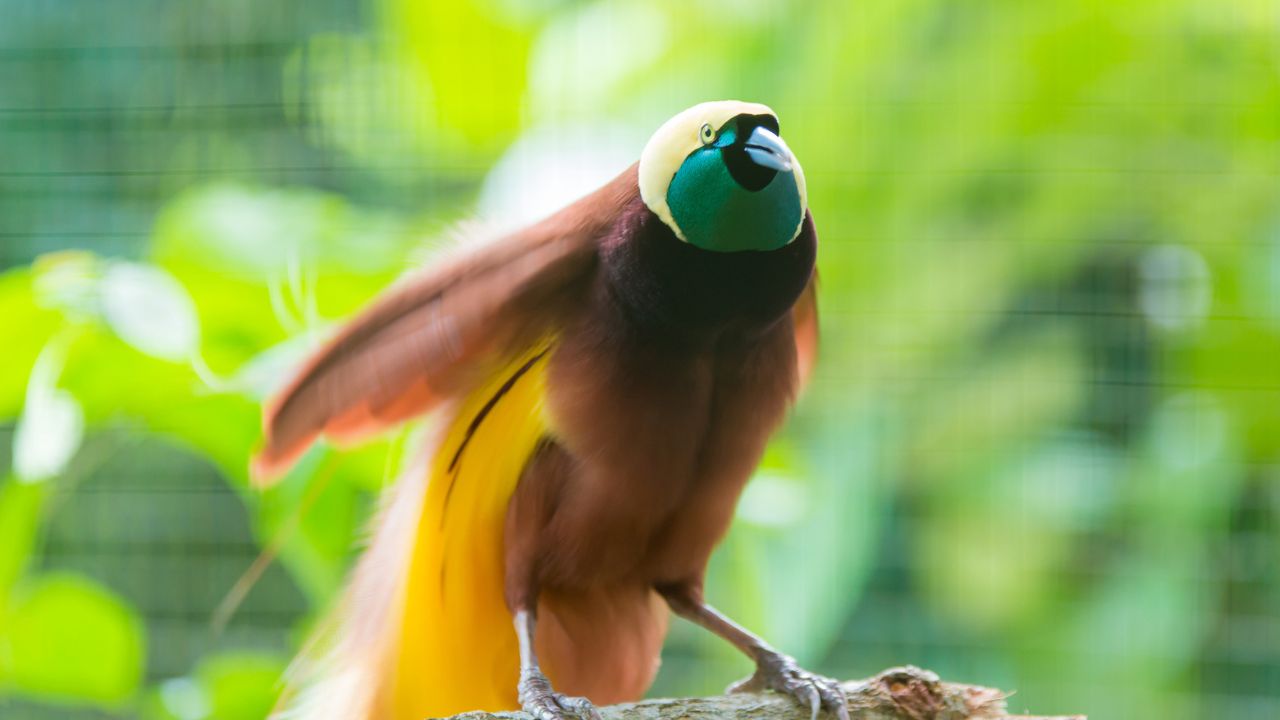
- Scientific Name: Paradisaea apoda
- Length: 17-19 in
- Wingspan: n/a
- Weight: 0.38 lb
The greater bird-of-paradise, found in southwest New Guinea and the Aru Islands in Indonesia, is a large bird of lowland and foothill forest and edge.
This species is sexually dimorphic and the females are bigger than the males. Males measure around 17 inches (without the tail) while females are 19 inches long on average.
Males are an extraordinary mix of colorful feathers and incredible flank plumes, making them a pleasure to behold. They have green faces, yellow crowns, heads and napes, black breasts, and white and vivid yellow tail plumes which they raise above their back during display.
These bright colorful tropical birds can be found on Trinidad and Tobago’s $100 bill. Males are polygynous and do not contribute to offspring raising in any way. Greater birds-of-paradise are omnivores that feed on fruit, seeds, and small insects.
White-faced Ibis
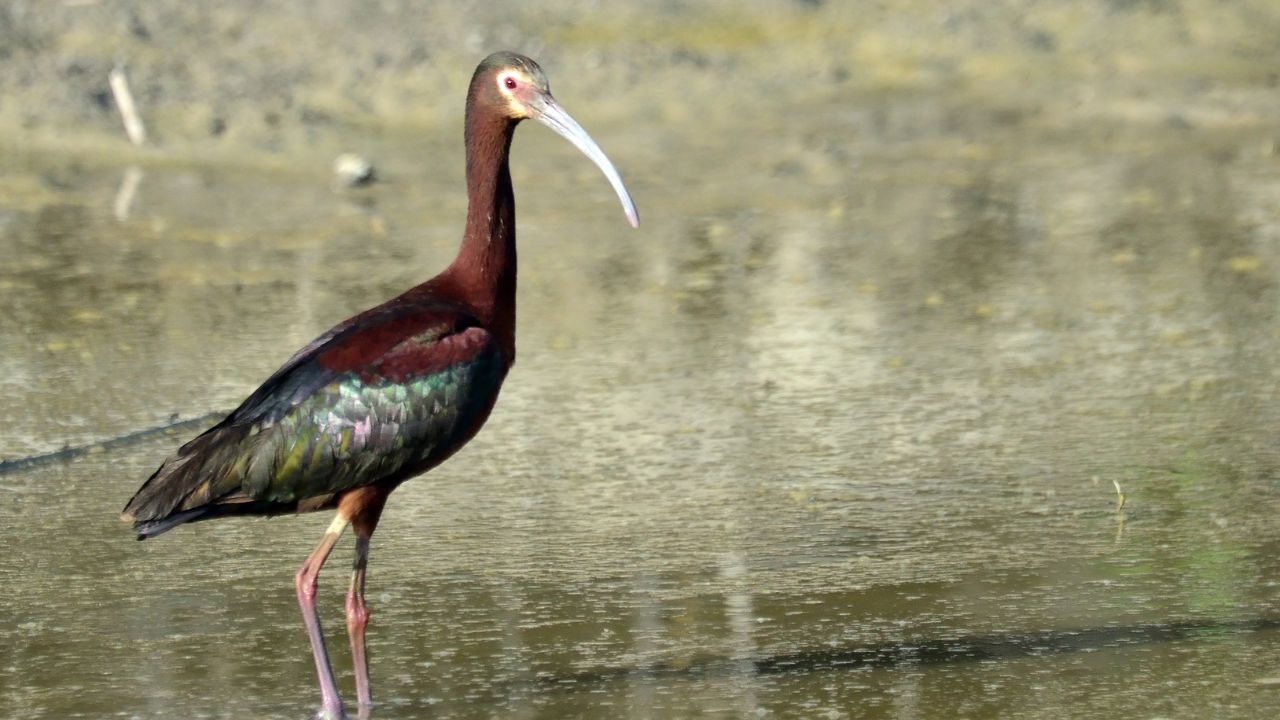
- Scientific Name: Plegadis chihi
- Length: 18-22 in
- Wingspan: 35-37 in
- Weight: 1.1 lb
White-faced ibises are among the largest ibis species in North America.
These birds measure from 18 to 22 inches long, weigh over a pound, and have a wingspan of around 35 inches. They might seem dark at a distance, but up close, white-faced ibises are a mixture of beautiful purple, green, and bronze.
Identify them by their long and downcurved beaks, glossy maroon plumage with iridescent green and reddish shades, white borders on reddish faces, and red eyes. They also have brightly colored legs that can range from pink to red.
These large birds are carnivores and feed on insects, snails, crayfish, leeches, some fish, and frogs – they will use their long beaks to probe the ground for prey. White-faced ibises breed in marshes in colonies and nests in low trees or bushes – females will lay 3-4 blue-green eggs.
Mandarin Duck

- Scientific Name: Aix galericulata
- Length: 16-19 in
- Wingspan: 26-30 in
- Weight: 1-3 lb
Mandarin ducks are one of the most colorful and beautiful birds in the world.
These exotic-looking ducks native to eastern Asia are related to wood ducks found in North America, another very colorful species.
Male mandarin ducks have purple breasts, orange “sails” on their backs, small red bills with whitish tips, and large white patches on the side of their heads (above the eyes). Females resemble female wood ducks and have white eye rings and stripes on their heads, brown backs, and pale bill tips.
Both sexes have very distinctive crests on their heads. After mating, males will molt and look similar to females.
Mandarin ducks are rather shy and can be mostly found in pairs or alone; when the winter comes, they might gather in larger flocks. These beautiful birds with brilliant feathers and striking colors are common around rivers, lakes, and parks with trees nearby.
As part of their elaborate courtship ritual, males will shake and bob their heads, mock drink and preen, and show off their crests and “sail feathers”.
Mandarin ducks are monogamous but the males leave after the young have hatched; females will raise their 9-12 ducklings on their own.
When they hatch, a mother will call the ducklings that jump from their nests which can be as high as 30 feet from the ground. Thanks to grass and fallen leaves to cushion the fall, the newborns are unharmed and move to water to feed.
Golden Pheasant

- Scientific Name: Chrysolophus pictus
- Length: 35-41 in
- Wingspan: 28 in
- Weight: 1.4 lb
Among the largest and most colorful birds in the world, golden pheasants will leave you speechless when you see them in person.
Also known as Chinese or rainbow pheasants, these large gamebirds are native to forests of western China. Europe, North, and South America also contain some feral populations of these birds.
Golden pheasants can measure up to 3.4 ft in length, span around 28 inches across the wings, and weigh around 1.4 pounds, making them also some of the largest red birds in the world.
Males have rusty red faces, throats, chins, and necks; on their heads, there are golden-yellow crests with a light tinge of red at the tip. Females have duller mottled brown colors. Both sexes have yellow legs and yellow beaks.
These large birds aren’t known for their flying skills and will forage on the ground, feeding on grain, leaves, and invertebrates.
Their beautiful plumage makes them very popular; capture for the pet trade, overhunting for food, and timber extraction have reduced their numbers in the wild. When the breeding season comes, male golden pheasants will often emit metallic calls.
Part of their scientific name “Chrysolophus” comes from Greek and means “with golden crest” while “pictus” is from Latin and means “painted;” referring to their unmistakable looks.
Scarlet Macaw
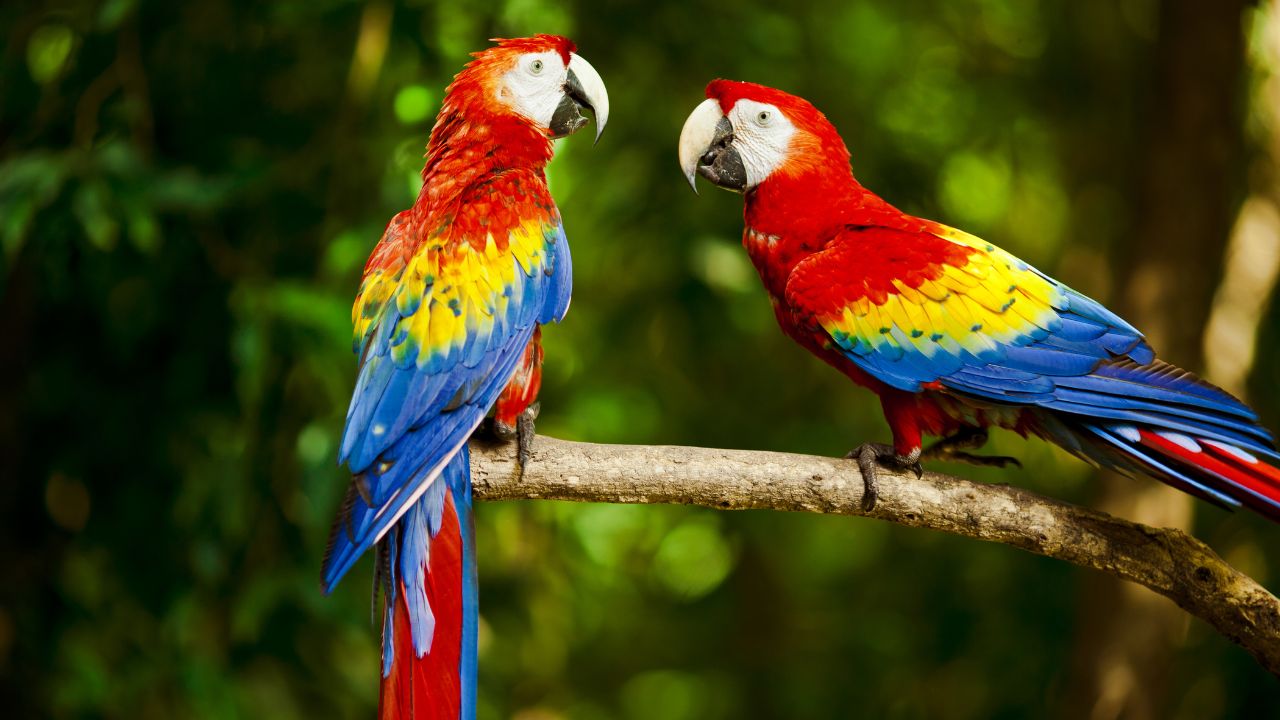
- Scientific Name: Ara macao
- Length: 32 in
- Wingspan: 39 in
- Weight: 2.2 lb
Scarlet macaws are one of the biggest and most colorful parrots in the world. Their feathers are like a rainbow of colors – they also span around 3.3 ft across the wings, measure 2.75 ft in length, and weigh around 2.3 lbs.
Their striking plumage makes them one of the most popular birds in aviculture. Scarlet macaws are mostly bright red with blue rumps and tail-covert feathers, dark blue wings, and yellow upper wing coverts. They also have white skin around their eyes and pale horn-and-black beaks.
These parrots can live a long life, typically from 40 to 50 years; some manage to survive for 90 years! Scarlet macaws are the national birds of Honduras and they breed in lowland rainforests and semiopen areas with big trees in Central and Southern America.
During their breeding period, they become extremely aggressive. Scarlet macaws are monogamous birds that stay together for life. These highly intelligent birds can also mimic human speech and will often make loud throaty squawks, squeaks, and screams to communicate with their group in the wild.
Red-And-Green Macaw

- Scientific Name: Ara chloropterus
- Length: 35-37 in
- Wingspan: 41-49 in
- Weight: 2.3-3.7 lb
Red-and-green macaws are the second-largest macaw species in the world, larger even than scarlet macaws; you will read later in this article about the largest one.
Red-and-green macaws resemble scarlet macaws – the main differences are the size, green upper-wing coverts in red-and-green macaws (yellow in scarlet macaws), and red lines around the bare white skin patches in red-and-green macaws.
Speaking of their appearance, red-and-green macaws have long pointed tails, red heads and bodies, and mainly blue wings and green wing coverts.
Also known as the green-winged macaws, these enormous colorful birds are common in forests and woods of northern and central parts of South America.
Their stunning looks have made them popular among poachers; such illegal trade and habitat loss have made their numbers decline in recent years. According to some estimates, there are just 50,000-100,000 of these birds in the wild today.
Red-and-green macaws are monogamous, mate for life, and can live up to 50 years in captivity.
Blue-And-Yellow Macaw

- Scientific Name: Ara ararauna
- Length: 30-34 in
- Wingspan: 41-45 in
- Weight: 2-3 lb
Blue-and-yellow macaws are large South American parrots that are also known as blue-and-gold macaws.
These colorful parrots live in forests, woodlands, and savannahs of tropical South America, mainly Colombia, Venezuela, Peru, Brazil, Bolivia, Ecuador, and Paraguay.
Blue and yellow macaws are hard to miss with their gorgeous turquoise-blue bodies, green foreheads, and dark lemon-yellow chests. Their feet are gray, their beaks are black, and their eyes are pale yellow.
Striking colors, ability to talk, availability in the marketplace, and close relationships with humans, make them a popular pet choice. In case you decide to get one, remember that these parrots can have a long life, up to 70 years and more.
Macaws are monogamous and remain together for life. While flying, pairs will stay close together with their wings nearly touching. Blue and yellow macaws love to eat seeds in the wild – they drop a lot of them on the forest ground which promotes forest growth.
Indian Peafowl
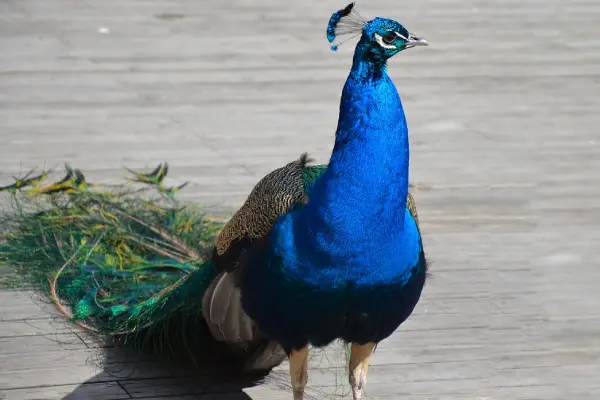
- Scientific Name: Pavo cristatus
- Length: 77-89 in
- Wingspan: 31-63 in
- Weight: 6.1-13.2 lb
The Indian peafowl are among the largest and heaviest members of the Phasianidae family that includes pheasants, partridges, junglefowl, chickens, turkeys, Old World quail, and other peafowl.
They are also known as common peafowl or blue peafowl and are native to the forests and farmlands of the Indian subcontinent. These large domesticated birds have been also introduced to many parts of the world.
Indian peafowl are sexually dimorphic – males (peacocks) and females (peahens) look different. Peacocks are brightly colored blue-green birds. They are iridescent blue and have ornamental greenish upper tail feathers when courting females. Females are much less colored and have shorter tails, white faces, green lower necks, and overall dull brown plumage.
The Indian blue peafowl is considered a sacred bird and a national bird of India. It symbolizes re-growth and rejuvenation, royalty, respect, honor, and integrity.
A group of peafowl is called ostentation, or pride, which certainly fits their appearance.
Green Peafowl
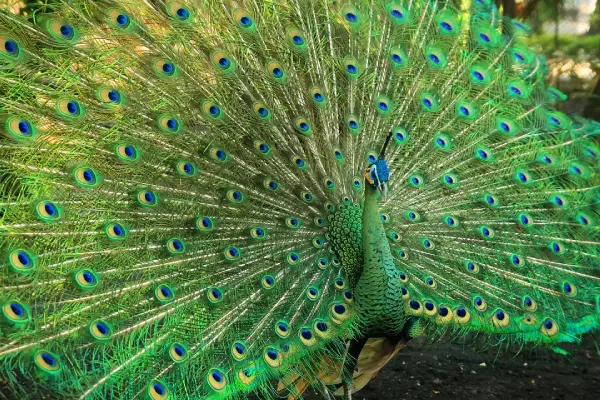
- Scientific Name: Pavo muticus
- Length: 39.4-118 in
- Wingspan: 47.2-63 in
- Weight: 8.5-11 lb
Green peafowl, also known as Indonesian peafowl, are massive peafowl species found in tropical forests of Southeast Asia.
Males can reach 9 feet 10 inches in total length including the tail covert (or “train”) that measures up to 5 feet 3 inches. Despite having such an enormous size, green peafowl are capable of sustained flight and can be often seen in the air.
Contrary to sexually dimorphic Indian peafowl, males and females of green peafowl look similar. Both sexes have green necks, dark wings, and dark green crests held up.
Males have glossy green upperparts, blue shoulders, and dark brown underparts. Females have dark tails with pale buff bars. Juveniles look like adult females but are duller.
Green peafowl are considered one of the most colorful and prettiest members of the galliform family. Their stunning plumage comes at a cost – hunting, poaching, and habitat loss have placed them on the list of Endangered species by the International Union for Conservation of Nature (IUCN).
Nicobar Pigeon
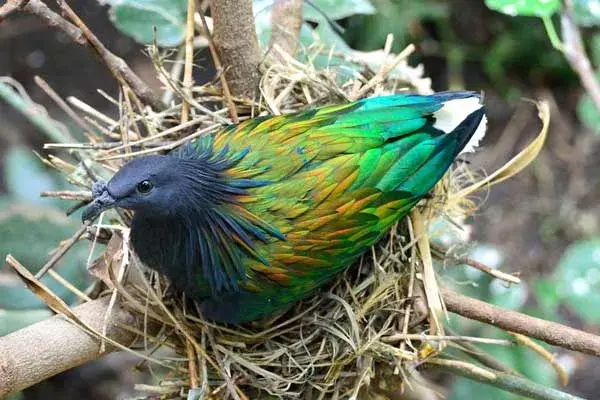
- Scientific Name: Caloenas nicobarica
- Length: 16 in
- Wingspan: 21-23 in
- Weight: 1-2 lb
Nicobar pigeons are striking birds with metallic gray-blue “manes” of hairlike feathers on their heads and necks. These long hackles match perfectly with the green and blue iridescent back and complement the green, blue, and copper wings.
Native to southeast Asia, Nicobar pigeons are large birds with broad wings, short tails, and black-brown eyes.
They are omnivores that feed on hard seeds, fruits, corn, and invertebrates. Because of their muscular gizzard (the “second” stomach a bird uses to grind food), Nicobar pigeons can digest some hard nuts that humans can only open with a hammer!
These beautiful blue and green birds are close relatives of the extinct Dodo bird.
Keel-Billed Toucan
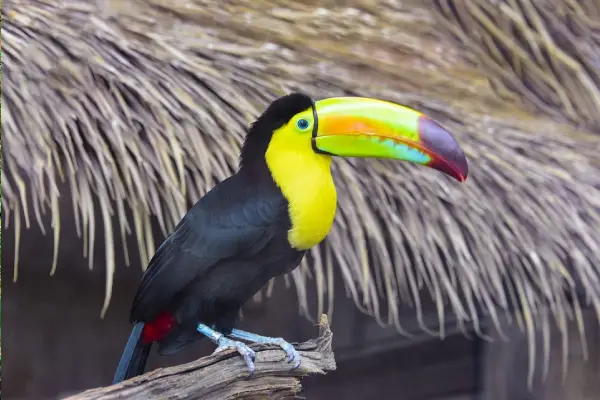
- Scientific Name: Ramphastos sulfuratus
- Length: 17-22 in
- Wingspan: 43-60 in
- Weight: 0.8-1.1 lb
Keel-billed toucans are large and unmistakable toucans with huge, rainbow-colored beaks.
These colorful birds are also known as sulfur-breasted toucans or rainbow-billed toucans but despite their enormous size, their beaks are very light. These birds are mostly black with yellow necks and chests, blue feet, red tail tips, and green, red, and orange beaks.
Despite their bright colors and large sizes, keel-billed toucans are hard to spot in the leafy canopy. These toucans live in tropical jungles from Mexico to Colombia – they are the national bird of Belize.
Similar to other toucan species, they are very social birds that rarely stay alone on their own. Keel-billed toucans will form groups of 6-12 individuals they fly and play with – one bird will throw fruit in the air for the others to grab it.
Roseate Spoonbill
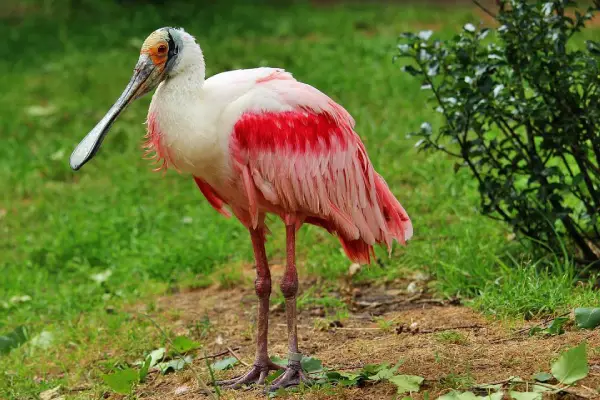
- Scientific Name: Platalea ajaja
- Length: 28-34 in
- Wingspan: 47-52 in
- Weight: 2.6-4 lb
Roseate spoonbills are unique big birds found in South and North America. In the USA, they are permanent residents of Southern Florida and Southern Texas.
These boldly colored birds look like they came out of a horror movie. They are gorgeous at a distance but quite bizarre up close because of their pink plumage that looks like it was dipped in blood.
Roseate spoonbills get their vivid pink coloration from the pigments called carotenoids – these birds will eat crustaceans and other aquatic invertebrates that are full of those pigments and turn their feathers pink.
It was these amazing feathers that almost got them extinct – people were hunting roseate spoonbills so much for their plumage that in 1920 there were only 179 of them left in Texas. Luckily, they managed to recover, rebuild their populations, and recolonize areas along the Gulf Coast.
Look for groups of pink birds foraging in the shallows of fresh and saltwater, often with egrets and ibises nearby. You should have no trouble spotting them by their colorful plumage, white necks, featherless heads, and long spoon-shaped bills they were named after.
Similar to humans, these birds will lose feathers from the top of their heads as they get older.
Great Blue Turaco

- Scientific Name: Corythaeola cristata
- Length: 28-30 in
- Wingspan: 28 in
- Weight: 1.7-2.7 lb
With a length of up to 2.5 ft, a weight of up to 2.7 pounds, and a wingspan of around 2.3 ft, great blue turacos are the largest species of turaco in the world.
These brilliantly colored, fruit-loving species are common in tropical rainforests of Africa, in Guinea, Sudan, Uganda, Tanzania, Western Kenya, DR Congo, and Angola.
Great blue turacos are big birds with gray-blue colors, upright blue-black crests, white chins, yellow beaks with orange-yellow tips, brown eyes, and black legs and feet. They are social birds that form groups of 6-7 individuals.
Not the best fliers, these big turacos will only pass short distances or soar down to lower levels of the forest. Great blue turacos have two distinctive calls, a deep “jeeeow” and a rapid, cackling series of very loud notes.
During mating season males become more vocal and territorial, and both partners will take turns in incubating their two blue eggs.
King Vulture

- Scientific Name: Sarcoramphus papa
- Length: 26-32 in
- Wingspan: 47.2-78.7 in
- Weight: 6-10 lb
King vultures are large, uncommon, and spectacular-looking birds found in Central and South America. They inhabit lowland tropical forests and range from Mexico down to Argentina.
King vultures are huge and predominantly white raptors – they also have bald colorful heads and necks, white eyes, and black edges on their wings and tails.
These birds of prey will soar high over the forest, searching for carcasses that smaller vulture species have gathered around, and use their size to drive them away before enjoying their meal. They are strictly scavengers and will never attempt to kill an animal, not even one near death.
King vultures are the third largest New World vultures, after the Andean and Californian condors. They are thought to be monogamous – they nest on the ground and a female will lay just one egg that both parents incubate and later raise.
Some suggest that their name comes from old Mayan legend where these vultures were referred to as “kings” that carried messages between Gods and humans.
Read More: What are some more examples of white-colored birds of prey?
Hyacinth Macaw

- Scientific Name: Anodorhynchus hyacinthinus
- Length: 39.3 in
- Wingspan: 51-60 in
- Weight: 2.6-3.7 lb
Hyacinth macaws are enormous birds native to central and eastern South America.
They are over 3 feet long which makes them the largest macaw and the largest flying parrot species in the world.
Hyacinth macaws are entirely cobalt blue, lighter above, and might occasionally have blue-gray neck feathers. They also have yellow rings around their eyes and under their beaks.
They live in scrublands on the outskirts of the rainforest, grasslands, and lightly forested regions of Brazil, Paraguay, and Bolivia. Despite the frightening appearance due to their enormous size and powerful, sharp hooked bills, hyacinth macaws have quite gentle nature.
They are herbivores that mainly feed on seeds, fruits, nuts, and berries. These parrots are social birds that form groups of up to 8 individuals and use different vocalizations, ranging from deep guttural growls and loud screeching to high trills when communicating.
Hyacinth macaws are endangered and some estimates claim there are 2,500-5,000 of them in the wild. They were even released in Florida, USA, but haven’t managed to form a permanent population there.
Besides humans (illegal trade), main bird predators, toco toucans, jays, and crows, will eat macaw eggs. People keep them as pets with the price for a young hyacinth macaw reaching well over $10,000.
Summary
From iridescent peafowl and stunning spoonbills to vibrant macaws, this has been our list of colorful big birds.
Some of these most colorful birds in the world get their stunning plumage from their diet (by consuming pigments that change their color) or from light refraction. Some of them are so captivating that it seems like they are defying the laws of nature.
We hope you enjoyed our article – feel free to share it with your friend and family.